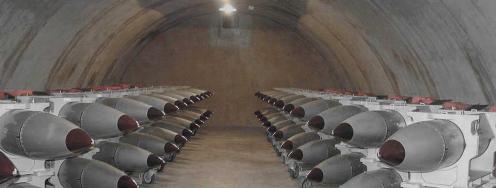NATO’s Nukes: Should They Stay or Should They Go?
On the radar: Strategy and optics; Expensive risks; Who might they deter; IAEA and Iran making progress; Iran and oil companies consider a deal; Questioning the need for new plutonium pits; Shaking up the nuclear field; Radiation hunters; and the Need for nuclear restraint in Asia.
On the radar: Strategy and optics; Expensive risks; Who might they deter; IAEA and Iran making progress; Iran and oil companies consider a deal; Questioning the need for new plutonium pits; Shaking up the nuclear field; Radiation hunters; and the Need for nuclear restraint in Asia.
August 26, 2014 | Edited by Geoff Wilson, Jacob Marx and Benjamin Loehrke
Get rid of them, eventually - “No matter what arguments we might make, pro or con, about keeping [NATO’s tactical nuclear] arms, it’s not the right time to remove them,” writes Tom Nichols for The National Interest. “Not because they have any utility, but because optics matter: Russian president Vladimir Putin’s open aggression against Ukraine currently makes it impossible for Barack Obama, or for any NATO leader, even to suggest anything that would look like capitulation to Russia.”
--“Saying that we should not remove these weapons in the middle of a crisis, however, does not then mean that there are any good reasons to hold on to them much longer. Tactical nuclear arms in Europe are literally outdated: not only are the bombs themselves reaching the end of their service life, but the strategy to employ them was overtaken by events twenty years ago.”
--“Keeping nuclear weapons in Europe isn’t a coherent strategy, but rather represents a cobbling together of fragments of various strategies from the past. Without the overarching concepts of extended deterrence and mutual assured destruction in which they were embedded, tactical nuclear arms do not carry some kind of magical deterrent power merely by existing…But there will be time, before Obama leaves office, for him to make good on bold promises made in his first term. Like George Bush the elder in 1991, he can use his famous ‘pen and phone,’ and bring home the last few-hundred souvenirs of Cold War nuclear strategy that we never wanted to use.” Full piece here. http://bit.ly/1q1xrQP
Expensive burden - “Are NATO based nuclear weapons an advantage in a dangerous world? Or are they an expensive and obsolete weapon that undermine NATO burden sharing? Is NATO divided about US nuclear weapons in Europe? Are the weapons secure? Are Euro-Hippies a threat to world peace?” Jeffrey Lewis and Aaron Stein discuss all this and more in their latest podcast for Arms Control Wonk. Listen to it here. http://bit.ly/1on36XD
A case for relevancy - Do NATO’s nuclear weapons still matter? Matthew Kroenig and Walter Slocombe argue they do and that “nuclear deterrence will remain a crucial part of NATO defense policy for the foreseeable future to deter the real (but remote) nuclear threats that the Alliance faces. They also examine the Russian, Iranian, and other threats that NATO nuclear weapons are intended to deter.” See their argument in an Atlantic Council brief. http://bit.ly/1rxdIuS
Dangerous weapons - “Are NATO-based nuclear weapons really an advantage in a dangerous world, as Brent Scowcroft, Stephen J. Hadley and Franklin Miller suggested in their Aug. 18 op-ed, ‘A dangerous proposition’? They are not. They make the world a far more dangerous place,” writes David Krieger of the Nuclear Age Peace Foundation in a recent Washington Post letter to the editor.
--“Nuclear deterrence is not a guarantee of security. Rather, it is a hypothesis about human behavior, a hypothesis that has come close to failing on many occasions...Rather than continuing to posture with its nuclear weapons in Europe, the United States should be leading the way in convening negotiations to eliminate all nuclear weapons for its own security and that of all the world’s inhabitants.” Read the Letter. http://wapo.st/1pcY1Hv
IAEA deadline - “Iran is ‘in the process’ of completing measures on transparency in its nuclear research that were agreed with the U.N. atomic agency, a senior Iranian official was quoted as saying, suggesting Tehran had at least partly met a Monday deadline for cooperation.”
--“Under an accord reached by the U.N. agency and Iran in November in an attempt to revive the long-stalled investigation, Tehran agreed in May to carry out five specific steps by Aug. 25 to help allay international concerns. They include providing information about two issues - for example, alleged explosives experimentation - that are part of the IAEA's inquiry into what it calls the possible military dimensions of Iran's atomic activities.” Fredrik Dahl and Michelle Moghtader have the story for Reuters here. http://reut.rs/1vfXNli
Tweet - @nukes_of_hazard: "...Cantor told Hoyer that he wanted a bill that would kill the interim agreement with Iran." http://t.co/MuQDVdo3S2 @NewYorker
Incentivizing a deal - Iranian officials have postponed a conference with international oil companies until February. The delay will allow companies to discuss interest in producing crude and natural gas in Iran after a final nuclear deal has been reached. Golnar Motevalli has the full story in Bloomberg. http://bloom.bg/1tzBHrP
The pits - “Los Alamos National Laboratory, birthplace of the atomic bomb, could ramp up production of triggers for nuclear weapons to levels not seen since the Cold War, if federal defense and energy officials get their way,” writes Patrick Malone in The New Mexican.
--“But questions abound over the proposal. Foremost among them: Are more pits needed? Thousands of pits already are warehoused at a storage facility in Texas that scientists say could be used to supply the needs of the nation’s nuclear industry for many decades… In a report to lawmakers this month, the Congressional Research Service describes a national defense agenda to produce 30 war reserve plutonium pits per year by 2026, and up to 80 pits per year by 2030.”
--“To put the magnitude of the strategy in perspective, the U.S. has produced a total of 30 pits — all at Los Alamos — between 2007 and the present.” Critics worry that, along with financial costs and potential environmental risks, “the mission at Los Alamos carries the further risk of eroding the trust of countries that, along with the United States, have committed to drawing down their nuclear stockpiles.” Full story here. http://bit.ly/1ruR2LH
Tweet - @nukes_of_hazard: "no one...is sure where the estimated $95 billion to build 12 new [nuke ballistic missile] boats will come from" http://t.co/dMiVaf3W9p
Innovation collaborative - “Five of the nation¹s largest funders of nuclear security and non-proliferation have hired Erika Gregory to lead a new, collaborative initiative aimed at bringing innovation into the 70 year old nuclear field. The funder collaborative, comprised of Carnegie Corporation, the William and Flora Hewlett Foundation, the John D. and Catherine T. MacArthur Foundation, Ploughshares Fund and Skoll Global Threats Fund, aim to drive more attention to their common goal of increasing nuclear security and decreasing risks from nuclear weapons.” Learn more about the new initiative here. http://bit.ly/VPtke5
Shaking things up - “It's a field that could use some shaking up, especially since the threat of nuclear materials inflicting mass casualties is actually higher now than during the Cold War days, according to many experts. So we were excited this spring to hear that a group of five funders was setting out to ‘disrupt’ the nuclear security arena by introducing ideas and insights from other fields,” writes David Callahan about the nuclear innovation collaborative for Inside Philanthropy. http://bit.ly/1tQmKQi
Flying Geiger counters - “The 1960s produced a lot of technological innovation in the science of mass destruction. But testing nukes also required learning how to detect the telltale signs of radiation. For survey teams flying in specially-equipped aircraft low above the Nevada desert, it was grueling and dangerous work. But what they learned not only taught us a lot about nuclear fallout, they helped establish environmental standards for both nuclear and non-nuclear power.” Full story from Steve Weintz for War is Boring. http://bit.ly/1t6ESZb.
Restraint - “Our nuclear future would take a significant turn for the worse if Beijing and New Delhi begin to mimic Cold War thinking about the utility of nuclear weapons. So far, they haven’t...Can the uncommon strategic constraint of these two rising powers continue?” asks Michael Krepon at Arms Control Wonk.
--“Nuclear restraint between Asia’s rising powers will be tested in the coming decade. How much of the ‘Asian way’ can be sustained with advancing warhead designs and ballistic missile defense technologies? How much will Beijing and New Delhi gear up the pace of their nuclear competition, with spill-over effects on Pakistan?” writes Krepon. “Much is riding on the resilience of Beijing’s and New Delhi’s uncommon strategic restraint.” http://bit.ly/YWg9KM
Quick-hits:
--“Woman Seeks to Erase Atomic Spying Case Conviction” by Larry Neumeister for the AP. http://abcn.ws/1pCnqcU
--“NKorea Protests UN Refusal of Meeting on Exercises” from the AP. http://abcn.ws/1qeBb0a
Event:
--“Iran Negotiations Update: Verification vs. Breakout Capacity” a discussion with Daryl Kimball and Stephen Rademaker, moderated by Barbara Slavin. Sept. 9 from 9:30-11:00am at The Atlantic Council. http://bit.ly/1ogX22L



